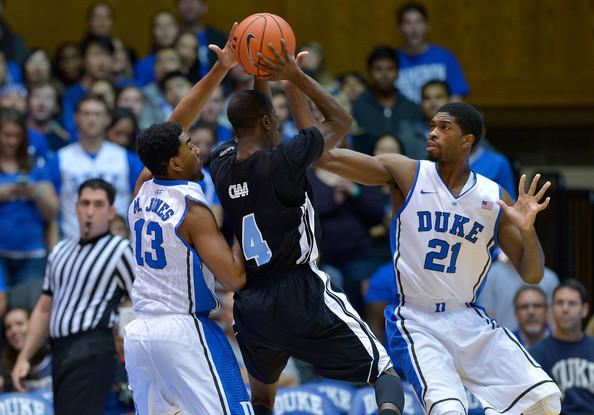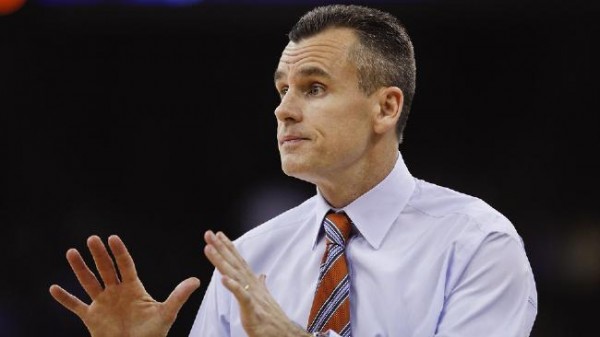Otskey’s Observations: On Duke’s D, Florida’s Struggles & Best Conference…
Posted by Brian Otskey on December 2nd, 2014Throughout the season, RTC columnist Brian Otskey (@botskey) will run down his observations from across the nation.
Duke’s Defensive Hiatus Is Over
If you’re a Duke basketball fan, you have to be encouraged by your team’s 7-0 start to the 2014-15 campaign. Coach Mike Krzyzewski’s top-ranked recruiting class has made, as expected, an immediate impact. Point guard Tyus Jones has been outstanding, averaging a six to one assist to turnover ratio in 27 minutes per game. When you have a steady floor general like Jones who can set up an offense with boatloads of talent, anything is possible offensively for Duke. But what I’d like to discuss is the Blue Devil defense, an area where we have seen the most change since last year’s Duke team was upset by Mercer back in March. Duke’s adjusted defensive efficiency has improved a whopping 101 spots year over year, from No. 116 in 2013-14 to No. 15 so far this year. The Blue Devils are back to being an elite defensive team, a staple of Coach K’s 34-plus year run in Durham. The biggest reason why is the roster turnover. Last year’s team had a non-traditional lineup, starting two 6’8” players and one listed at 6’9”. Specifically, Rodney Hood and Jabari Parker were primarily offense-oriented players who liked to drift out to the perimeter and provided little on the defensive end of the floor. Once opponents were able to get by Duke’s guards, there was little to resist them in the paint. Without a strong front line to defend the basket, the Blue Devils’ interior defense suffered mightily. Duke allowed opponents to shoot 50.3 percent from two point range last season.

Duke’s roster turnover has made it better defensively.
(Photo: Grant Halverson/Getty Images North America)
Fast forward to the current season and that number has dropped to 45.9 percent as we enter December. That one category is still not elite by any means, but Duke makes up for that by fouling considerably less than it did last year and forcing more turnovers. The result is an overall defense that is night and day from last year. While Jahlil Okafor is more known for his offense, he does provide a more traditional presence in the middle and that alters shots. Duke’s frontcourt that runs 6’6”, 6’9” and 6’11” this season as opposed to last year’s non-traditional lineup makes a big difference defensively. This group has a lot of room still to grow defensively and I expect them to become even better on that end of the floor as the season moves along. You have to have a strong defense to win a national championship and Duke is back to being a contender this year because of it. Last year, we could not say the same despite garnering a No. 3 seed in the NCAA Tournament.
Florida’s Early Season Struggles
One of the nation’s most disappointing teams to date has to be Billy Donovan’s Florida Gators. Ranked No. 7 in both major preseason polls, Florida has stumbled to a 3-3 start after struggling offensively while at the same time battling injuries to a couple of key players and a suspension. Did everyone (myself included) who ranked Florida highly give the Gators the benefit of the doubt because of their coach, recent history and the name on the front of the jersey, without looking deeper at the roster? It is a distinct possibility. In six games, Florida’s best offensive output has been 68 points against William & Mary in the very first game of the season. The injury bug has hit the Gators hard, with Dorian Finney-Smith and Eli Carter each missing two games. To add insult to those injuries, Chris Walker was suspended for two games as well. The question is, how much of Florida’s poor start can be attributed to the personnel issues?
To me, it seems like the injuries and the suspension of Walker mask bigger issues offensively. Florida has very little scoring depth even when at full strength, with only five players who can be counted on for quality production on a somewhat regular basis. A bigger question concerns Walker. Was this consensus five-star recruit overhyped? In 22 career college games, Walker has yet to crack double figures in scoring or rebounding, despite seeing an uptick in minutes played in four games this season. While it is still very early in Walker’s college career, there is room for doubt. Going forward, Florida should get better as it gets healthy and Donovan learns more about his team. However, opportunities for quality wins will be scarce in the SEC. With only a game at Kansas this coming Friday and a home contest with Connecticut left of note on its non-conference schedule, I don’t think it’s too far-fetched to imagine Florida sweating it out on Selection Sunday. While it is way too early to make any definitive statements, Florida’s worst start through six games since the 1996-97 season, Donovan’s first as head coach, certainly makes you wonder about what could be in store a few months from now.
Which Conference is the Nation’s Best?
An annual conversation this time of year always seems to center around which conference is the best in college basketball. While the sample size of games is still relatively small, my vote would go to the Big Ten in a close race over the Big 12. Everyone rates conference strength differently. For me, I like to look at a number of factors including strength at the top, depth in the middle and weakness at the bottom. Come March, a lot of people will judge a league’s strength by the amount of teams it gets into the NCAA Tournament, a perfectly legitimate viewpoint. While everyone is entitled to their opinions, I think those who look at the strength of a particular league at the top don’t look hard enough at the depth of a league from the very top to the very bottom. People who subscribe to this line of thinking will most likely say that the ACC is the best league in college basketball. There is no doubt, the ACC is the best conference at the top as you can argue four of its teams are amongst the nation’s top 15 or better. But that opinion ignores the vast mediocrity in the middle of the ACC and the very poor teams at the bottom of this very large league. I think that has to count as well.
When I look at the Big Ten, I see one elite team (Wisconsin) followed by a group of very strong teams in the second tier (Michigan State, Ohio State and Michigan). After that, I see an astounding six other quality teams capable of making the NCAA Tournament. That doesn’t even include Indiana which, despite its dysfunction off the court, could possibly contend for a bid as well. In my view, 11 of the 14 Big Ten teams are at worst good and at best elite. Every league has bad teams as well and the Big Ten is no different, but this league has a minimal amount of bad teams given such a large membership. The same can be said for the Big 12, but I feel the Big Ten as a complete group is just a notch above the Big 12 as it stands now. Of course, we have the rest of the season to see how this all plays out and refine our judgments.












































